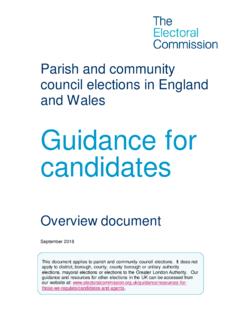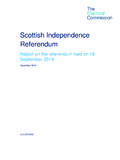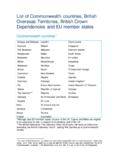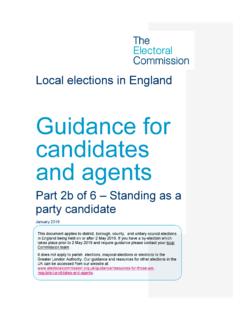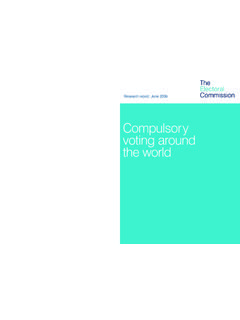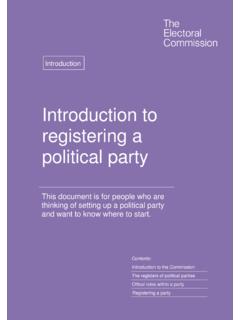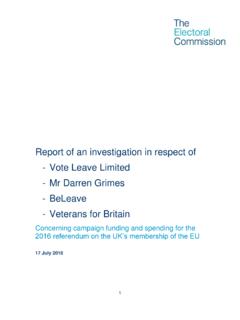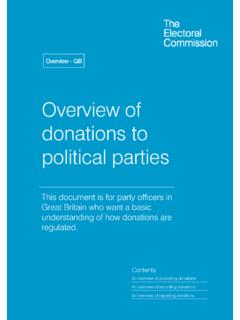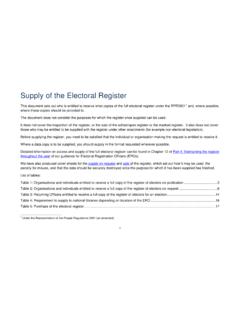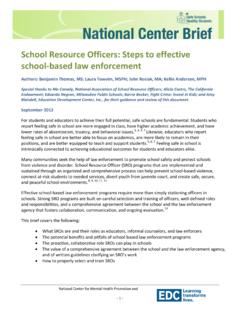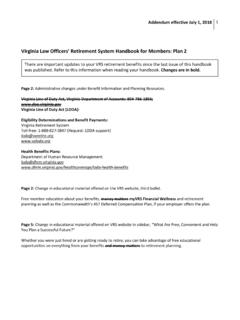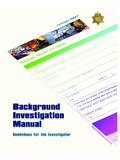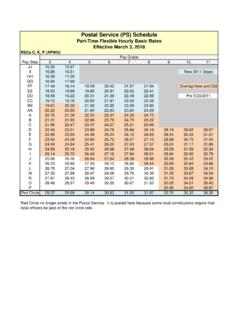Transcription of Guidance for Electoral Registration Officers
1 Guidance for Electoral Registration Officers Part 2 The Registration framework July 2018. Updates to this document Updated Description of change September 2013 Original publication May 2015 Updated for the 2015 canvass and the period leading up to the May 2016 polls July 2015 Revised for Scotland to reflect The Scottish Elections (Reduction of Voting Age) Act 2015. This change applies to any elections in Scotland that use the local government register (and only the local government register) for the purpose of determining the franchise. November 2015 Revised to reflect the end of the transition being brought forward to December 2015. July 2016 Updated to remove references to electors who are not registered individually; to reflect the new performance standards; and to reflect the Representation of the People (England and Wales) (Amendment) Regulations 2016. June 2017 Updated to include legal references and make minor consequential amendments; to reflect the transfer of functions from the Chancellor of the Duchy of Lancaster to the Minister for the Cabinet Office i; to reflect the Representation of the People (Scotland) (Amendment).
2 Regulations 2017; to add reference to the ERO being a senior officer (paragraph ); and to, add in links to examples of good practice in Electoral Registration . March 2018 Updated to: take account of the EU General Data Protection Regulation (GDPR) (effective from 25 May 2018). and the Data Protection Bill provide revised contact details for immigration checks (paragraphs and ). highlight that a change to the British Nationality Act 1981 is required to amend the list of commonwealth countries (paragraph ). June 2018 Paragraphs and have been updated to reflect that in some limited circumstances, convicted prisoners who have been released on temporary licence may meet the criteria to register to vote. July 2018 Paragraph has have been updated to reflect that fact that Gambian nationals resident in the UK are now eligible to register to vote. i The Transfer of Functions (Elections, Referendums, Third Sector and Information) Order 2016.
3 Contents 1 About this Guidance .. 1. 2 Your role and responsibilities .. 3. Electoral Registration officer .. 3. Electoral Registration team .. 8. Resources .. 8. 3 Eligibility to register .. 9. Relevant 9. Qualifying address .. 10. Residence .. 10. Age .. 16. 17. 4 How to register .. 28. Registration channels .. 28. 5 Maintaining the property database .. 35. 1 About this Guidance This is the second part of the comprehensive Guidance for EROs on planning for and delivering well-run Electoral Registration services. It sets out the legislative framework governing Electoral Registration , including the roles and responsibilities of Electoral Registration Officers (EROs). The Guidance is directed towards the ERO and the duties they carry out. As these duties may, in practice, be carried out by deputies and/or appointed staff, we use the term you' throughout this Guidance to mean the ERO and whoever is carrying out the ERO's functions on their behalf.
4 Throughout this document we use must' to refer to a specific legal requirement and may / should' for recommended practice. It has been developed in close consultation with members of the Society of Local Authority Chief Executives (SOLACE), the Association of Electoral Administrators (AEA), the Scottish Assessors Association (SAA), the UK. Electoral Coordination and Advisory Board (ECAB) and the Elections, Registration and Referendums Working Group (ERRWG). It reflects the ERO's legal obligations and what we, the AEA, SOLACE, the SAA, the ECAB and the ERRWG believe that EROs should expect of their staff in planning for and delivering well-run Electoral Registration services. S. The Guidance relating to the Scottish Elections (Reduction of Voting Age). Act 2015 has been developed in close consultation with the SAA, AEA. and the Electoral Management Board for Scotland (EMB), and reflects what the SAA, AEA and EMB believe EROs in Scotland should expect of their staff in planning for and delivering well-run Electoral Registration services in relation to young electors.
5 Any specific considerations or differences arising from this legislation are highlighted in break-out boxes like these throughout the Guidance . The Guidance is based on the legislation listed in paragraph of Part 1 . Planning for the delivery of Electoral Registration activity. Whenever there are any changes to the legislation, we will provide further Guidance and support to EROs and update the relevant Guidance Parts as appropriate. Legislative references are included throughout the Guidance as endnotes. As there are two versions of the Representation of the People Regulations 2001: one for England and Wales, and one for Scotland; both versions of the legislation are referenced. For example, Regulation 26(1)(j) 2001 Regulations, RPR (Scotland) 2001 is referring to Regulation 26(1)(j) in both the England and Wales version and the Scotland version of the 2001 Regulations. You will find references to the performance standards framework embedded throughout the Guidance .
6 The overall objective of the performance standards 1. framework is to support EROs in planning for and delivering well-run Electoral Registration services. The framework was developed around key outcomes from the perspective of ensuring that all eligible people are able to participate in the Electoral process, should they wish to do so, and of achieving Electoral registers that are as accurate (including ensuring no fraudulent entries on the Electoral register) and complete as possible. Our Guidance , tools and templates, along with support provided by our teams across England, Scotland and Wales, will continue to help you to plan for and deliver well-run Electoral Registration services. The tools and templates we have made available are highlighted in break-out boxes throughout the Guidance . We have been working with the AEA to identify specific examples of good practice in Electoral Registration . The following resources have been published on our website and are highlighted in break-out boxes throughout the Guidance .
7 Use of tablets in Electoral Registration Communications Reaching care home residents Effective personal canvassing Encouraging responses Reaching students Effective use of available data Effective management of Registration processes Our resource on the EU General Data Protection Regulation and the Data Protection Act 2018 also contains examples of good practice in relation to data protection. 2 Your role and responsibilities Electoral Registration officer In order to be able to vote in elections in Great Britain, a person's name must be included in a register of electors. Responsibility for compiling the register of electors lies with the ERO. In England, the council of every district and London borough is required to appoint an officer of the council to be the ERO. In the City of London, the Common Council must appoint an officer as the ERO. In Wales, the appointment of the ERO is made by the county or county borough council, and the person appointed must be a current officer of the council.
8 In Scotland, the ERO must either be appointed by the local authority or by a combination of local authorities. The person appointed must either be an officer of that council or an adjoining council. The ERO should be a senior officer , for example the Chief Executive/Head of Paid Service, and should undertake relevant training to ensure that they have, and maintain, the skills required for the role. As ERO you have a duty to maintain a register of parliamentary electors and a register of local government electors, 1 as well as a register of relevant citizens of the European Union entitled to vote at European Parliamentary elections 2 and a register of those peers living outside the UK who have made a declaration to vote at European Parliamentary elections. 3 These registers contain the details of all those who are registered to vote and must be combined as far as is practicable. Any reference to the register' in this Guidance manual should therefore be construed as a reference to the combined registers unless otherwise stated.
9 In Scotland, the franchise for Scottish Parliamentary and local government S elections includes 16 and 17 year olds. This means that the local government register will include 16 and 17 year olds as full electors. Additionally, 15 year olds and some 14 year olds are entitled to be included on the local government register as attainers'. For the purposes of the local government register in Scotland, an attainer is someone who turns 16 by the end of the twelve months following the 1 December after the relevant date' (see Chapter 3 for more information on the relevant date'). 3. The combined register will therefore need to make clear the date on which those included on it that are under 18 years of age will become 18 years old in order to clearly show their eligibility to vote in different elections. No information on those aged under 16 must be included on any version of the register published or otherwise made available, except in very limited circumstances.
10 For further information, see Chapter 11 of Part 4: Maintaining the register throughout the year. You must also produce an edited (or open') version of the register. 4. Throughout this Guidance we use the term edited register', as this is the technical term used in the legislation. The term open register' is used to describe the edited register to members of the public to make it easier to understand the purpose of this register and how it is used. In specific instances where we do mention the edited register in this context, we will refer to the edited register as the open register'. The edited register contains only the names and addresses of those on the full register who have not taken the decision to opt out of their details appearing on the edited register. S. In Scotland, a person under 16 years old is automatically opted out of the edited register. The details of any person under 16 years old must not be included in any version of the published register, including the edited register.
